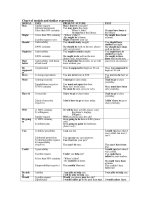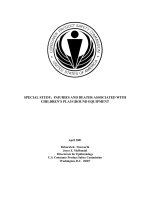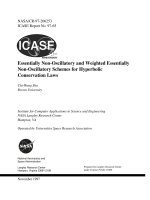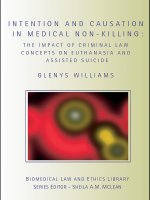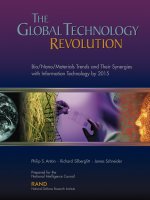Distributed data reconciliation and bias estimation with non gaussian noise for sensor network
Bạn đang xem bản rút gọn của tài liệu. Xem và tải ngay bản đầy đủ của tài liệu tại đây (673.88 KB, 126 trang )
DISTRIBUTED DATA RECONCILIATION AND BIAS ESTIMATION
WITH NON-GAUSSIAN NOISE FOR SENSOR NETWORK
JOE YEN YEN
(B.Eng.(Hons), M.Eng., NUS)
A THESIS SUBMITTED
FOR THE DEGREE OF DOCTOR OF PHILOSOPHY
NUS GRADUATE SCHOOL
FOR INTEGRATIVE SCIENCES AND ENGINEERING
NATIONAL UNIVERSITY OF SINGAPORE
2010
i
Acknowledgment
Advisors always come first in the acknowledgment, and without aiming for political
correctness, I would say it is rightly so. As much as the PhD has been a hard time for
me, I believe it has not been any less so for my advisors. I am grateful to Dr Lim
Khiang Wee, Prof Ling Keck Voon, Prof Ho Weng Khuen and Dr Zhang Jing Bing,
without whom this thesis would never have been. Prof Ling Keck Voon and Prof Ho
Weng Khuen, in particular, have devoted immeasurable time and effort to pull this
thesis into being.
The generous help and guidance of Prof Jose Alberto Romagnoli of Louisiana State
University during the initial conception of the thesis is also greatly acknowledged.
During the long PhD journey, many precious individuals have been my pillars of
support. My friends Zhao Sumin, Quek Boon Kiat, Lee Hui Mien, Kiew Choon
Meng, Syahfitri Undaya, Sri Winarsih, Valdomiro Peixoto, and many others, have
supported me in more ways than they know. My family has been the force that
sustains my journey. My in-laws have provided family comfort away from home.
Finally, my husband, Ng Boon Ping, has shared everything with me through times
of darkness. No words are significant enough to express my gratitude.
ii
Table of Contents
ACKNOWLEDGMENT I
TABLE OF CONTENTS II
SUMMARY V
LIST OF TABLES VII
LIST OF FIGURES VIII
CHAPTER 1.
INTRODUCTION 1
1.1
M
OTIVATION
1
1.2
C
ONTRIBUTIONS
5
1.3
O
UTLINE OF THE THESIS
7
CHAPTER 2.
DISTRIBUTED DATA RECONCILIATION (DDR) 8
2.1
I
NTRODUCTION
8
2.2
D
ATA
R
ECONCILIATION
(DR) 9
2.3
D
ISTRIBUTED
D
ATA
R
ECONCILIATION
(DDR) 12
2.3.1
Overview 12
2.3.2
Example 1: A two-node network 12
2.3.3
Example 2: A three-node network (see Figure 2.2) 21
iii
2.3.4
The general N-node network 34
2.4
C
ONCLUSION
39
A
PPENDIX
2A 40
A
PPENDIX
2B 45
A
PPENDIX
2C 48
CHAPTER 3.
APPLICATION CASE STUDY OF DDR 52
3.1
I
NTRODUCTION
52
3.2
P
LANT DESCRIPTION
53
3.3
E
XPERIMENT SETUP
54
3.4
E
XPERIMENT
&
R
ESULTS
55
3.5
C
ONCLUSION
60
CHAPTER 4.
DISTRIBUTED BIAS ESTIMATION (DBE) 61
4.1
I
NTRODUCTION
61
4.2
B
IAS
E
STIMATION
63
4.2.1
Least squares (LS) bias estimation 64
4.2.2
GT-based bias estimation 66
4.3
A
NALYSIS OF
E
STIMATOR
P
ERFORMANCE
68
4.3.1
Influence Function (IF) and Estimator Variance 68
4.3.2
IF of LS Estimator 69
4.3.3
IF of IQR+LS Estimator 70
4.3.4
IF of GT based Estimator 71
4.3.5
Example 1: A simple 2-sensor system 72
4.4
D
ISTRIBUTED
B
IAS
E
STIMATION
(DBE) 75
4.4.1
Overview 75
4.4.2
Example 2: A three-node network 76
4.4.3
Distributed BE (DBE) for the N-node network 83
4.5
C
ONCLUSION
84
iv
A
PPENDIX
4A 86
A
PPENDIX
4B 88
A
PPENDIX
4C 91
A
PPENDIX
4D 93
CHAPTER 5.
APPLICATION CASE STUDY OF DBE 96
5.1
I
NTRODUCTION
96
5.2
P
ERFORMANCE OF THE BIAS ESTIMATORS
97
5.3
C
ONCLUSION
102
A
PPENDIX
5 103
CHAPTER 6.
CONCLUSION & FUTURE WORK 106
BIBLIOGRAPHY 111
AUTHOR’S PUBLICATIONS 116
v
Summary
The advancement of sensor network technology presents both a new platform and a
challenging environment for sensing applications. An important challenge is to
incorporate techniques to remove measurement corruptions, to which sensors are
perpetually prone. Data reconciliation (DR) is a measurement adjustment technique
commonly used in the process industry to deal with measurement corruptions. It
improves measurement accuracy by ensuring their consistency; measurements are
adjusted according to known relationships among the measured variables and based
on the statistical characteristics of the sensor precision. However, DR has traditionally
been performed in a centralized manner, where measurements are collected from all
sensors to a central node to be processed. This thesis considers DR in a distributed
sensor network environment and distributes the linear steady-state DR computation to
the nodes in the sensor network. The distributed DR (DDR) is derived, and an
implementation algorithm is developed. As each sensor node actively participates in
the distributed DR, it is robust to the failure of any node, and gracefully degrades
when more than one nodes fail. Illustrative examples are presented to demonstrate the
proposed DDR, while an application case study of an experimental-scale chemical
vi
plant demonstrates its usefulness.
Sensor biases are prevalent in all sensing applications, and bias estimation proves
an important tool in ensuring measurement accuracy. In this thesis, instead of
collecting all measurements to a central processing node to estimate their biases, the
intelligence of the sensor nodes is leveraged to perform bias estimation in a
distributed manner. The performance of the Generalized T (GT), inter-quartile range
test cum least-square (IQR+LS) and least-square (LS) bias estimators used in the
distributed bias estimation (DBE) are analyzed through both theoretical tools and
experiments. The theoretical tools relate the estimator type and sample size with the
estimation variance. As such, besides providing a basis for theoretical performance
comparison among the bias estimators, the theoretical tools allow one to design the
estimator to achieve specified variance, or provide one with an expected estimator
precision for a given set of estimator parameters and sample size. The theoretical
results are verified experimentally with the application case study of an experimental-
scale chemical plant.
vii
List of Tables
Table 2.1: Example 1: Distributed DR processing in a basic two-node network 18
Table 2.2 : Example 2: distributed DR processing in a three-node network 26
Table 2.3 : Example 2: reconstruction of a missing node in the three-node network 31
Table 4.1: Example 1: Estimates of the means
1
y
and
2
y
for all combinations of
1
y
and
2
y
74
Table 4.2: Example 2: Estimates of the means
1
y
,
2
y
and
3
y for all combinations of
1
y
,
2
y
and
3
y 78
Table 5.1: Bias estimation results for data without outliers 99
Table 5.2: Bias estimation results for data with 25% outliers 3 times larger than
original data 99
Table 5.3: Bias estimation results for data with 10% outliers 10 times larger than
original data 99
viii
List of Figures
Figure 2.1. A two-node sensor network 13
Figure 2.2. A three-node example 22
Figure 3.1. An experimental-scale chemical reaction plant 53
Figure 3.2. Flow diagram of the chemical reaction plant in Figure 3.1 54
Figure 3.3. Diagram of sensor network for flow sensors in Figure 3.1 55
Figure 3.4. Reconstruction of a failed node: Node 2 fails at time = 19s 58
Figure 3.5. Degradation of estimate variances as increasing number of nodes fail 59
Figure 4.1. A three-node sensor network 76
Figure 5.1. Influence functions (IF’s) of the LS, GT and IQR+LS estimators 102
1
Chapter 1. Introduction
1.1 Motivation
Intelligent sensor network is a collection of autonomous devices that measure
characteristics of their environment, perform local computations, and communicate
with one another over a network [1]. Termed sensor node, each of these devices is
typically small, low cost and battery operated [2]. These characteristics make them
very attractive: their compact size means that they can be placed inconspicuously
without disrupting the environment that they are sensing [3]; the low cost means that
they can be deployed in large number, resulting in dense deployment with high
redundancy; and being wireless and battery-operated, they are free from the
constraints of communication and power infrastructure, such that they can be placed
anywhere and their placement can be easily adjusted, for example to optimize
coverage of the phenomena or detectability of an event.
Sensor measurements, however, are prone to corruptions. As inexpensive sensors
are used in sensor networks to achieve dense deployment and perhaps, the required
minimal form factor, they tend to be corrupted or fail more easily. Techniques to
remove these measurement corruptions are therefore especially important in sensor
2
networks applications [1,3,21].
Data reconciliation (DR) [4] is a measurement adjustment technique commonly
used in the process industry to deal with measurement corruptions. It improves
measurement accuracy by ensuring their consistency; measurements are adjusted
according to known relationships among the measured variables and based on the
statistical characteristics of the sensor precision. The sensor network deployment
makes it suitable for application of DR, as the sensors usually measure spatially
correlated signals. Such correlations mean that there exist functional relationships
describing the behaviors of the measured signals in terms of one another, which are
therefore fitting for use as a basis for reconciliation of the sensor measurements. In
fact, reconciliation of measurements is the procedure that enables the physical
redundancy of the sensor deployment to be leveraged, to compensate for the lower
quality of the low-cost sensors.
A straightforward way to perform DR in sensor networks is to download the
measurements from all sensor nodes in the network, and then have a central
processing node carry out the reconciliation [1]. In this case, each sensor node need
not possess any knowledge of correlations with other nodes, nor perform any
computation, nor engage in meaningful communication (collaboration) with other
nodes. The central node must therefore maintain the knowledge of correlations among
all sensors, perform all necessary algorithmic steps and handle transmissions to and
from all the sensor nodes. Although there are cases in which the centralized approach
is more appropriate, for example, when it is desired to collect all the raw
measurements to a central location, there are good reasons to prefer a distributed
approach [1,5].
A major drawback of the centralized approach is that there is a communication and
3
computation bottleneck at the central processing node [5]. A crucial implication of
this is that the DR processing is critically dependent on the availability of the central
processing node. Any disruption or failure of the central processing node will affect or
worse, halt, the DR processing. There is also a gross under-utilization of the
computational power of the intelligent nodes in the network. A scheme that leverages
the capabilities of the intelligent sensors to eliminate dependence on a central
processing node is therefore desired.
While DR reduces the effect of random noise on data, assumptions made by
conventional DR approaches are often restrictive. More specifically, the conventional
least square estimator has an implicit assumption on the normality of data. However,
data in practice are more often than not subjected to the occurrence of outliers,
transients in a supposedly steady-state period, instrument failure, human error and
other process nature that renders the data non-normal. If approaches based on
normality assumption are used on the non-normal data, poor estimates may result. For
example, a single huge outlier can skew the least-square estimates significantly. It is
therefore imperative to consider data processing approaches that are robust to outliers
[11, 12].
As DR focuses on the treatment of random measurement corruptions, additional
steps must be taken to correct for systematic measurement corruptions. Bias, which
can be caused by miscalibration of sensors or some instrument malfunction, is a
prevalent type of systematic corruption [17]. The intelligent sensor nodes must
therefore be equipped with capabilities to treat bias [3,6-7,22-26].
In this thesis, a strategy to deal with outliers and biases is proposed. The
Generalized T (GT) distribution is chosen to represent the measurement noise. With
this approach, there is no assumption of normality (Gaussian distribution) on the data,
4
and outliers are modeled instead of removed from the data set. Furthermore, as a more
general distribution, the GT can adapt to many common distributions, including the
Gaussian distribution, through varying the GT distribution parameters. The proposed
GT-based strategy also makes use of linear consistency model relating measurements
of neighbouring sensors, hence utilising the spatial redundancy among the sensors.
Two relevant topics in sensor network are known as online sensor data cleaning and
distributed calibration. In the following, several representative works under these
topics are described and compared with the work in this thesis.
In contrast to the proposed GT-based strategy, other popular approaches in the field
of sensor network [21,27,30], as summarized below, assume Gaussian distribution of
the measurement data. Using these approaches, outliers are detected/ identified
through statistical tests based on Gaussian assumption, before being removed from the
data.
The work of Elnahrawy and Nath [21] seems to be exemplary in online sensor data
cleaning in sensor network. In this work, Bayesian estimation is used to give more
accurate estimate of the true value measured by a sensor, given the measurement of
the sensor, random characteristic of the measurement (likelihood) and the prior
distribution of the true measured value. Cleaning is therefore done in a single sensor
basis, without making use of related measurements from a node’s neighbours (spatial
redundancy).
Spatial information is taken into consideration in the more recent work of Ji and
Szczodrak [27], where some estimate of covariances among neighbouring nodes are
obtained using steady-state data. The
2
χ
test based on the estimated covariances is
then performed on tuples containing the measurements of the neighbouring nodes, to
detect and identify outliers. The use of the
2
χ
test implies Gaussian assumption on
5
the measurement noise.
Jeffery et al [28] proposed a multi-tiered architectural framework to clean sensor
data. Both temporal and spatial redundancies are considered; however, as the main
focus of the work is to propose the architectural framework, only very simple,
heuristic outlier detection/identification and smoothing (replacement of outliers with
interpolated values) techniques are presented in the form of declarative queries.
However, similarly heuristic techniques to deal with outliers seem to be common in
other online sensor cleaning approaches [29]. For example, Mukhopadhyay et al [29]
uses a tree-structure decision analysis coupled with ARMA prediction model to
estimate a “true value” for a sensor measurement. Decision is then made to either use
the actual measurement of the sensor or the estimated value as the corrected/cleaned
data point.
The use of linear consistency model has been considered under the topic of
calibration in sensor network, i.e. in the work of Balzano et al [6]. However, although
the importance of distributed implementation has been emphasized, this work does
not outline the distributed algorithm of the proposed calibration method.
1.2 Contributions
The distributed data reconciliation (DDR) is derived to enable a group of intelligent
sensors to perform DR in-network in a distributed manner. Algebraic analysis of the
conventional (centralized) DR is conducted and the distributed DR is formulated.
An implementation algorithm for the DDR is developed. In the proposed DDR
algorithm, each sensor node is made aware of itself and its neighbours, is fully in
charge of computations and coordination with other nodes to reconcile its own data,
6
and is able to respond to abnormal situation such as a missing/failed neighbouring
node. The dependence on a central processing node to perform DR is eliminated,
making the distributed DR robust to the failure of the central processing node.
A case study is conducted by applying DDR in an experimental-scale chemical
plant to demonstrate the procedures of DDR and its usefulness in maintaining
operation despite node failures.
To handle biases and outliers in the sensor measurements, the distributed bias
estimation (DBE) with the Generalized T (GT) estimator is derived and its
implementation algorithm developed. Similar to DDR, DBE enables a group of
intelligent sensors to perform bias estimation (BE) in-network in a distributed manner,
such that the dependence on a central processing node to perform bias estimation is
eliminated.
For comparative studies with the GT-based DBE, the inter-quartile range test cum
least square (IQR+LS) and the traditional least-square (LS) estimators are also applied
in DBE. The performance of these estimators are analyzed using theoretical tools
based on the Influence Function (IF). In the light of the equations derived in this
thesis, an efficient estimator can be selected. In the presence of outliers that are close
to good data, the equations show that using GT, instead of normal distribution, to
characterize sensor data gives rise to a more efficient estimator than the LS and
IQR+LS in terms of estimation variance.
The case study of the experimental-scale chemical plant is also conducted to
demonstrate the procedures of DBE and to study the performance of the GT, IQR+LS
and LS estimators.
.
7
1.3 Outline of the thesis
This thesis is organized as follows. Chapter 2 presents the proposed distributed data
reconciliation (DDR). The proposed DDR is applied to a case study of an
experimental-scale chemical plant in Chapter 3. Chapter 4 presents the proposed
distributed bias estimation (DBE). The case study of the experimental-scale chemical
plant is also conducted for the DBE, with the experiment described and the results
discussed in Chapter 5. Finally, Chapter 6 presents the conclusion of the thesis.
8
Chapter 2. Distributed Data
Reconciliation (DDR)
2.1 Introduction
In this chapter, distributed DR is derived and an implementation algorithm is given.
The goal is for DR to be performed entirely in-network, hence eliminating problems
associated with having a central processing node. Indeed, in the proposed approach,
each sensor node actively participates and takes responsibility in reconciling their
own and their neighbors’ measurements, through local computation and collaboration.
In this case, not only are the computation and communication capabilities of the
sensor nodes in the network leveraged, but also, a certain level of autonomy, or at
least awareness, is assigned to the sensor nodes. With such autonomy/awareness,
these nodes can collaborate and reconcile with their neighbouring nodes, hence
reducing unnecessary communication with other parts of the network. In addition, a
certain level of parallelism can be achieved across groups of independent nodes.
By distributing the processing and communication burden in a meaningful way to
each sensor node, the distributed DR is more robust to failures of one or more nodes.
9
In contrast, the centralized approach is vulnerable to the failure of the central
processing node, which will result in the complete failure of DR processing.
In the field of sensor network, the topic of reconciling sensor measurements using
consistency model has recently gained attention. Termed model-based distributed
sensor calibration [6], this topic is probably best represented by the works of
Bychkovskiy et al [7] and Guestrin et al [1]. The main difference between the work in
this chapter and these two works is in the consistency model used. Bychkovskiy et al
[7] assumed very dense deployment, such that all sensors measure the same variable.
Guestrin et al [1], on the other hand, worked in the probabilistic inference domain and
as such, their consistency model is in the form of joint probability distribution of the
measured variables. The work in this chapter, however, uses any linear consistency
model and set the reconciliation problem as an optimization problem using the linear
model as constraints. Balzano et al [6] also proposed a strategy for model-based
sensor calibration that uses a range of linear models. In relation to [6], the work in this
chapter may be seen as an extension in terms of providing a distributed framework for
linear model-based sensor calibration.
This chapter is organized as follows. In the following section, the topic of DR is
first introduced. The proposed DDR is then presented in detail in Section 2.3. Section
2.4 ends the chapter with concluding remarks.
2.2 Data Reconciliation (DR)
Data reconciliation is well-studied in the area of process engineering [4,17-20] and
only the relevant equations necessary for the derivation of the distributed algorithm
are given. The mathematical formulation of the linear steady-state DR is as follows.
10
Let there be
n
sensors, making
T
n
yyy ][
1
…
= measurements.
Measurement model: In the absence of gross errors, the measurement model can be
expressed as:
ε
+
=
x
y
, (2.1)
where
T
n
xxx
][
1
…
=
are the actual measured variable and
ε
represent the
measurement noises of each sensor for the particular set of measurements.
Furthermore, let the measurement noise have the following characteristics:
The expected value of
ε
is a null vector, i.e.
0}{
=
ε
E . (2.2)
The covariance matrix of the measurement errors is known and positive definite, i.e.
}{)(
T
ECov
εεε
=Ψ= . (2.3)
Consistency relationship model, or DR constraints: The DR constraints consist of
equations describing how the measured variables
T
n
xxx ][
1
…
= are inter-related. In
linear steady-state DR, it can be expressed in the matrix form:
0
=
Ax
, (2.4)
11
where each row of
A
is one constraint, i.e. a linear equation relating
n
xx
…
1
.
The DR problem:
With the measurement model in (2.1), assumptions on the noise
in (2.2)-(2.3), and the constraints in (2.4), the DR is cast as a constrained weighted
least-square problem:
0)( s.t.
min
1
=−
Ψ
−
ε
εε
ε
yA
T
. (2.5)
Solution of the DR problem:
Using Lagrange multiplier approach, the DR problem
above can be solved for the estimates:
error estimate:
AyAAA
TT 1
)(
ˆ
−
ΨΨ=
ε
(2.6)
reconciled estimate:
ε
ˆ
ˆ
−
=
yx
(2.7)
estimate covariance:
ΨΨΨ−Ψ=Ψ=
−
AAAAx
TT 1
)(
ˆ
)
ˆ
cov(
. (2.8)
Note that for a unique solution to exist, the constraint matrix
A
must satisfy the
usual conditions for solvability of the least square problem, i.e. if
A
is an
Nm
×
matrix, then
Nm
<
and
(
)
mArank =
.
12
2.3 Distributed Data Reconciliation (DDR)
2.3.1 Overview
This section presents in detail the proposed distributed data reconciliation (DDR)
algorithm. Due to the rather involved algorithms of the distributed DR, illustrative
examples of a two-node (Section 2.3.2) and three-node (Section 2.3.3) networks are
provided in this section to give the reader a basic understanding of the distributed DR
algorithm and to contrast it with the centralized DR. Section 2.3.3 then describes the
general distributed DR for an
N
-node network, while the detailed implementation
algorithm can be found in Appendix 2A.
2.3.2 Example 1: A two-node network
Consider a sensor network consisting of two sensor nodes, related through a
constraint
0
21
=− xx
(Figure 2.1). Given the measurements of the two sensors:
[ ]
[
]
T
T
yyy 8210
21
+==
,
with their corresponding variances:
1
2
1
=
σ
, 2
2
2
=
σ
.
The DR problem can be stated as (2.5), where in this case,
13
Figure 2.1. A two-node sensor network
[
]
[
]
TT
xyxy
221121
−−==
εεε
,
[
]
[
]
11
1211
−== aaA
,
=
=
=Ψ
2
1
2
2
2
1
2221
1211
σ
σ
ψψ
ψψ
.
Centralized DR:
In a centralized scheme, all processing is done at a single location. Assume that in
this example, the single location is at Node 2. The reconciled estimates can be
calculated by Node 2 in a centralized manner using (2.6)-(2.8), resulting in
[
]
T
21
ˆ
−=
ε
,
[
]
T
x 2929
ˆ
3
2
3
1
3
2
3
1
++=
,
and
=Ψ
3
2
3
2
3
2
3
2
ˆ
.
1,210
11
=+=
σ
y
0
21
=
−
xx
2,8
22
==
σ
y
14
Obviously, in order to carry out the above calculations, Node 2 must have the
values of
1
y
,
2
y
,
1
σ
,
2
σ
and
A
. The measurement
1
y
is usually an average of
readings taken by the sensor in Node 1, while
1
σ
is the variance of the readings. This
means Node 1 has to send a number of its sensor readings to Node 2, so that Node 2
can compute
1
y
and
1
σ
. Also, the constraint matrix
A
must be stored in Node 2.
Distributed DR:
In the proposed distributed DR, instead of Node 2 doing all the processing, Node 1
and Node 2 share the processing and communicate to complete the data
reconciliation. Table 2.1 (which can be found at the end of this chapter) shows the
details. Node 1 and 2 each computes and holds its own measurement average and
variance, and keeps its own constraint and covariances relating it with each other, as
seen in the initialization step, Step 0 of Table 2.1.
To compute the reconciled estimates and estimate covariances, the nodes need data
from each other, in addition to their own local data. To do this, the nodes go through a
series of computation and communication procedures as follows (see also Steps 1-3 of
Table 2.1):
(i) Computation of local results using local node data:
Node 1 computes, locally:
( )
.1 Nodeat 0 since 1
,210
121111121211111
1111
===+=
+==
ψψψψθ
aaa
yar
15
Node 2 computes, locally:
( )
.2 Nodeat 0since 2
,8
212212221221112
2122
=−==+=
−==
ψψψψθ
aaa
yar
(ii) Aggregation of local results to compute reconciled estimates and covariances:
After local computation, Node 1 sends its local results
(
)
11
,
θ
r
to Node 2, which
then aggregates them with its local results as follows:
.3
,22
212111
21
=+=
+=+=
θθφ
aa
rrr
With these aggregate values, Node 2 can now compute its own reconciled
estimate and covariances, as follows:
.
ˆ
,
ˆ
,
ˆ
where;29
ˆ
ˆ
3
2
2
2
1
2222
3
2
12
1
12
1
2121
2
1
2
3
2
3
1
222
=−=
=−=−=
=+=−=
−
−−
−
θφψψ
θθφθθφψψ
θφεε
ryx
Similarly, Node 2 also shares its local results
(
)
22
,
θ
r
with Node 1, such that the
latter can also compute its reconciled estimate and covariances, as follows:
.
ˆ
,
ˆ
,
ˆ
where;29
ˆ
ˆ
3
2
21
1
21
1
1212
3
2
2
1
1
1111
1
1
1
3
2
3
1
111
=−=−=
=−=
=+=−=
−−
−
−
θθφθθφψψ
θφψψ
θφεε
ryx
16
The exact sequence of the above processing steps can be found in Table 2.1.
Note that the resulting estimates are equivalent with those obtained in the
centralized DR. This can be shown by gathering the computations and results from the
two nodes and writing them in matrix form as follows. Firstly, the aggregates can be
written in terms of centralized variables as follows:
Ayyayarrr
=+=+=
21211121
,
(
)
(
)
T
AAaaaaaaaa Ψ=+++=+=
22122111121212111111212111
ψψψψθθφ
.
Then, the error estimates can be written in matrix form as follows:
(
)
( )
( )
,
ˆ
ˆ
1
22122111
12121111
1
2
1
1
2
1
AyAAAr
aa
aa
r
TT
ΨΨ=
+
+
=
=
−
−−
ψψ
ψψ
φ
θ
θ
φ
ε
ε
which is identical to the expression for error estimates of the centralized DR in (2.6),
as
T
A
A
Ψ
is a scalar quantity. Similarly, the estimate covariances can also be written
in matrix form as:
( )
( )
( )
1
1
2
212
21
2
1
2221
1211
2221
1211
ˆˆ
ˆˆ
−
−
ΨΨΨ−Ψ=
−
=
TT
AAAA
φ
θθθ
θθθ
ψψ
ψψ
ψψ
ψψ
,
which, similarly, is identical to the expression for the estimate covariances of the
centralized DR in (2.8).
Furthermore, note that the local results
p
θ
and
p
r
(p = 1 for Node 1, and 2 for Node
2) are actually the basic building blocks in the computation of the DR solutions

